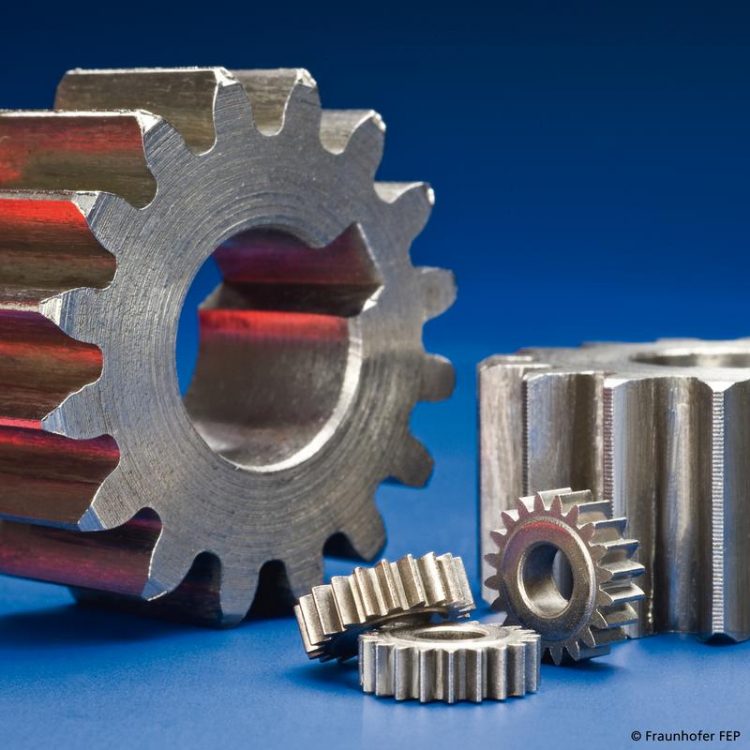New techniques and opportunities for 3D component coating

Coating of 3D components © Fraunhofer FEP
Coatings play a considerable role in increasing the functionality of components. High-performance applied layers protect components from premature mechanical wear and tear, chemical and thermal degradation or minimize frictional losses in dynamic systems. Under operating conditions coated 3D parts are exposed to extreme stress since the effects are maximized at higher temperatures and pressures, or components must bear the same loads at reduced weight. Component and coating must therefore be matched to each other in order to withstand these load conditions, which increasingly demands systems of layers with complex composition.
With the aim of developing resource-conserving and efficiency-raising technologies in machinery and plant engineering, industry also faces the challenge of cost efficiency in coating of components with three-dimensional geometry for functional optimization.
NOVELLA, an experimental platform jointly developed by Fraunhofer FEP and CREAVAC GmbH, offers efficient high-rate electron beam deposition of 3D components. The facility permits pre-treatment, plasma-activated evaporation as well as hybrid processes in which electron beam technology can be combined with magnetron sputtering and plasma-activated chemical vapor deposition.
Dr. Jens-Peter Heinß, head of the Component Coating Group at Fraunhofer FEP, explains: “The design of the installation offers our research partners and industrial clients currently unique capabilities for feasibility studies and material development. The high coating rates that we achieve enable the processes to be planned and executed more productively and in the end more economically.”
Dr. Heinß will be presenting the innovative design of the unit at the 15th International Conference on Plasma Surface Engineering in Garmisch-Partenkirchen, Germany from September 12-16, 2016.
Fraunhofer FEP will be conducting a dedicated workshop on the new installation entitled “Vision Components” on October 11, 2016. The NOVELLA facility and its vacuum coating capabilities will be presented to an audience of technical experts from various branches of industry and science there. Current trends in vacuum coating engineering, such as wear protection and tribologic applications, will be discussed and new approaches to solutions will be presented.
Important results for developing the design of NOVELLA experimental platform were incorporated from the collaborative project “3DEB” funded by the European Union and the Free State of Saxony (grant agreement no 100 146 071).
Press contact:
Annett Arnold
Fraunhofer Institute for Organic Electronics, Electron Beam and Plasma Technology FEP | Phone +49 351 2586 452 | Annett.Arnold@fep.fraunhofer.de
Winterbergstraße 28 | 01277 Dresden | Germany | www.fep.fraunhofer.de
Media Contact
All latest news from the category: Power and Electrical Engineering
This topic covers issues related to energy generation, conversion, transportation and consumption and how the industry is addressing the challenge of energy efficiency in general.
innovations-report provides in-depth and informative reports and articles on subjects ranging from wind energy, fuel cell technology, solar energy, geothermal energy, petroleum, gas, nuclear engineering, alternative energy and energy efficiency to fusion, hydrogen and superconductor technologies.
Newest articles

Bringing bio-inspired robots to life
Nebraska researcher Eric Markvicka gets NSF CAREER Award to pursue manufacture of novel materials for soft robotics and stretchable electronics. Engineers are increasingly eager to develop robots that mimic the…

Bella moths use poison to attract mates
Scientists are closer to finding out how. Pyrrolizidine alkaloids are as bitter and toxic as they are hard to pronounce. They’re produced by several different types of plants and are…

AI tool creates ‘synthetic’ images of cells
…for enhanced microscopy analysis. Observing individual cells through microscopes can reveal a range of important cell biological phenomena that frequently play a role in human diseases, but the process of…





















